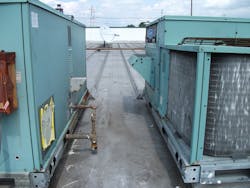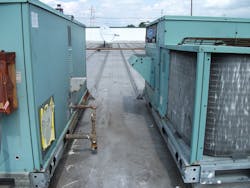The transition from emergency heating calls to spring maintenance is here. In the rush, getting caught up in endless checklists and missing the fundamentals is easy. Health and safety are two fundamentals that are easy to overlook. Each maintenance call has clues when you know what to look for.
While this article focuses on gas-fired package units, many principles also apply to split systems. Let's look at four signs you can look for during your spring maintenance calls that may reveal hidden CO (carbon monoxide) safety issues.
Heat Exchanger Cracks
Even though you're checking the cooling operation, visually inspecting the heat exchanger is still a good idea. A cracked heat exchanger is the most obvious sign of a CO safety issue in any gas-fired unit. You probably have the blower panel off and easy access to this component. In some cases, you may need to remove an additional panel.
Inspect the heat exchanger for signs of overheating, metal stress, or cracks. You should address any opening, no matter how small. Cracks only get worse over time. Don't just offer a replacement when you identify a heat exchanger issue. Instead, find out why the original failed and address the cause at the same time. Otherwise, the new heat exchanger will also fail.
Low airflow is a common source of heat exchanger failure. Some frequent causes of low airflow are:
- Dirty or restrictive evaporator coils
- Dirty blower wheel
- Slipping or worn belts
- Incorrect replacement blower motor
- Dirty or restrictive filters
- Closed fire dampers
- Poorly designed and installed ductwork.
Some issues are easier to find than others. If you suspect low airflow as the cause of heat exchanger failure and nothing obvious stands out, grab your manometer and measure equipment TESP (total external static pressure). Chances are that if airflow is low, your measured TESP will be greater than the maximum-rated TESP found on the unit's nameplate.
Rust in the Burner Compartment
A common CO safety visual clue easily overlooked is rust. While we often think of rust in a package unit as normal, there is usually a reason it's present.
Rusted heat exchanger surfaces are another frequent source of failure. Rust weakens metal to the point that it eventuallyCO2 (carbon dioxide) makes up a large part of flue gas. It is heavier than air and can migrate back into the burner compartment. Flue gas also contains acidic moisture that attacks any metal components in the burner compartment. If you have ever had difficulty removing a rusted spark ignitor or burner, you have seen what I'm talking about.
Improperly installed replacement inducer motors are another common cause of flue gas recirculation.
Improperly installed replacement inducer motors are another common cause of flue gas recirculation. Look closely at the replacement and ensure there aren't any unintentional gaps. Any gaps or misalignment in the replacement inducer connections will cause flue gas to short-circuit and spill into the burner compartment.
Another source of recirculation has to do with equipment location. Rooftop equipment often sits inside parapet walls. If there is no relief opening, heavier flue gas stays near the equipment and can recirculate into the burner compartment. Ground-level package units can also have this problem if there are privacy fences around the equipment.
Soot in the Inducer Outlet
Soot in some package units is another clue. It's a black, sticky substance usually found inside the induced draft blower outlet. Soot is carbon in its pure form and is unacceptable in any fuel-burning appliance because it represents unsafe equipment operation.
Soot is a product of unburned fuel and the result of improperly fired equipment. If you see soot, the equipment has likely produced high CO at some point. When you find it, do not leave the equipment operating in heating mode with this condition. Disable the heat until you identify and correct the cause before the next heating season.
Poor Economizer Location
Economizer location is easy to overlook. This component is the source of outside air for ventilation purposes. Sometimes that outside air can come from nasty places, especially if the package unit is at ground level. This situation also applies to heat pump package units as well as gas-fired equipment.
Once you finish your equipment maintenance, step back and look at the economizer installation. Ask yourself, "Where does the outside air come from that's going into this unit?" Look for additional CO sources that could enter the equipment through the economizer or a leaking access panel.
If you're on a roof, look for nearby water heater flues or the exhaust from other package units. At ground level, check parking locations and other outdoor activities near the unit, such as a charcoal grill.
Privacy fences around ground-level units can also cause flue gas recirculation into the economizer. Once inside the air handling system, these poisonous gases spread throughout the building for occupants to breathe.
Take Five
You can find many of these visual signs while performing routine maintenance tasks. But now you're looking at the equipment through a different set of lenses. I encourage you to keep your eyes open because you may not revisit the same job site.
It only takes about five minutes to look for these clues while doing your other work. Don't just trust your eyes if you see something suspicious. Go the extra step and do some combustion testing to validate or alleviate your concerns. No visual inspection is 100% reliable, so trust your gut. Remember, unless you test, it's just a guess.
David Richardson serves the HVAC industry as Director of Training for the National Comfort Institute, Inc. (NCI). NCI specializes in training focusing on improving, measuring, and verifying HVAC and Building Performance.
If you're an HVAC contractor or technician interested in learning more about combustion safety testing, contact David at ncilink.com/ContactMe or call 800-633-7058. NCI's website, www.nationalcomfortinstitute.com, is full of free technical articles and downloads to help you improve your professionalism and strengthen your company.
About the Author
David Richardson
Director, technical curriculum
David Richardson serves the HVAC industry as director of technical curriculum at National Comfort Institute, Inc. (NCI), Avon, Ohio. NCI specializes in training that focuses on improving, measuring, and verifying HVAC and Building Performance.

